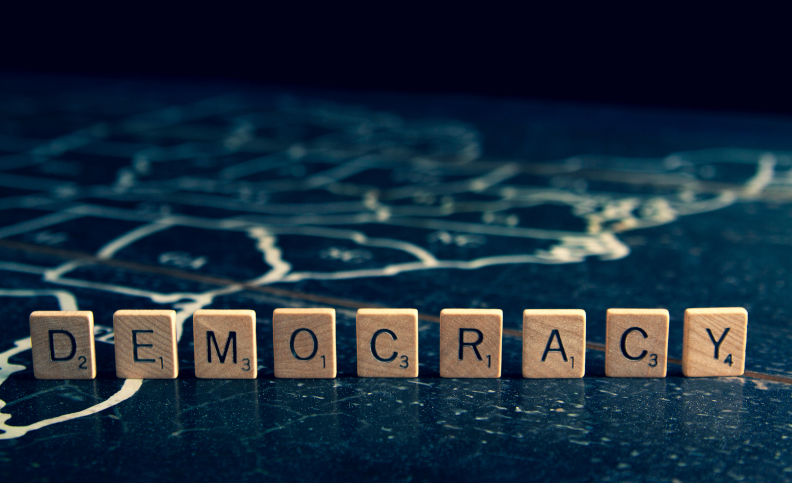Jeff Bezos recently announced that the Washington Post would henceforth dedicate its op/ed pages to “free markets and personal liberties”. His Whole Foods business also asked the National Labor Relations Board to “set aside the results of a union election” that endorsed collective bargaining. The Australian social psychologist Alex Carey explained these interrelated events in the 1970s and 80s. We owe a debt to former Tasmanian Speaker Andrew Lohrey for making Carey’s explanation available after his premature death.
In his 1995 introduction to Carey’s essays titled Taking the risk out of democracy: corporate propaganda versus freedom and liberty, Noam Chomsky described Carey as “a close personal friend and a valued co-worker”. He also depicted the dedication to Carey of Manufacturing Consent (1988) as “a bare and inadequate way to try to express our indebtedness to him for his uniquely important work”.
In the essays, Carey tracked the long history of the American propaganda exercise labelled “public relations”, deployed by business to ensure the public is marshalled behind their goals, whatever the cost to that public.
Public relations began, he explained, around World War I. Employers had faced the triple challenge of muckraking journalists exposing their wrongdoing, labour organising for less miserable conditions and an expanded vote. Wartime propagandists moved on into the corporate world to serve a managerial class keen to draw on the new knowledge: Edward Bernays, the father of public relations, wrote that business “realised that the great public could now be harnessed to their cause as it had been harnessed during the war to the national cause, and the same methods could do the job”.
In the Great Steel Strike of 1919, the public initially supported the strikers who worked 84-hour weeks “under notoriously bad conditions”.
The onslaught of publicity built the “anti-Red hysteria” that made the McCarthy era possible long after it had turned the public against the strike.
During the 1920s, communications theorist Harold Lasswell warned: “If the mass will be free of chains of iron, it must accept chains of silver.”
In 1935, the Wagner Act required collective bargaining with America’s workers. The National Association of Manufacturers was one of the primary vehicles for business propaganda fighting back. NAM’s president reported to his members: “You will note especially that this is not a hit or miss program. It is skilfully co-ordinated so as to blanket every media… and then… it pounds its message home with relentless determination.” In 1936, this was codified as the Mohawk Valley Formula; “employer mobilisation of the public… in a labour dispute.”
After World War II, the campaign escalated to destroy the New Deal and wartime conditions that constrained the industrialists. In 1950, NAM estimated its annual publications would stack to the height of the Empire State Building. “Economic education” of workers was begun in the schools and drummed in through workplaces and churches.
New businesses, such as the Opinion Research Corporation and the Psychological Corporation, were established to manage the polling and public relations that took the temperature of public opinion and manipulated it for business interests.
In spring of 1946, 81% of the public was polled as valuing the work done by the federal Office of Price Administration to stop price gouging. NAM spent $3,000,000 to “kill” it. Advertising and publications designed specifically for teachers, for clergymen, for farm leaders and women’s clubs were augmented by NAM’s speakers making a “thousand talks” before such civic organisations. By autumn of 1946, NAM inverted those figures so that a mere 26% supported the OPA.
After Congress abolished the Office later that year, consumer prices rose 15% and food 28%.
By 1961, Carey quoted historian Daniel Boorstin as mourning the impact of the advertising industry broadly on America. “We think it has meant an increase of untruthfulness. In fact,it has meant a reshaping of our very concept of truth.” By that stage, Carey assessed, the idea that there might be an ethical component to the deployment of public relations had been lost.
The 1960s disillusionment in America over Nixon and the war in Vietnam led to another surge in business’ efforts to control the message and convince the public that the economic sector held the key to truth.
In Australia and the UK, where business’ public relations had not taken hold as they did in the US, Carey argued that we retained a better balance between government, worker and business. Both British and Australian business leaders, “conservative” economists and politicians desired to emulate the American model that was achieving business supremacy. (Charles Kemp, George Cole and Keith Murdoch had tried in 1943 to begin this importation of the American strategy through their Institute of Public Affairs.)
Under the auspices of Mont Pelerin Society-connected economists and actors, the 1970s and 80s saw the rash of “thinktanks” founded in Australia to replicate the strategies that had remade America for “free markets”. Dominic Kelly told the tale of that era, in a book named for Bob Hawke’s assessment of the ideologues involved: “political troglodytes and economic lunatics.”
Initially the tobacco industry matched mining in donations to Australia’s “institutes” where “corporate-funded intellectuals” manufactured the messages that must be absorbed to make Australia more like America. Carey related his shock at returning from researching in the US to find that the American Enterprise Institute, had made the University of NSW its antipodean outpost.
Carey describes the Heritage Foundation as one of the American bodies that worked to mould the public and direct politicians for the donors’ goals. One of its founders, Ed Feulner, was brought to Australia by the Quadrant journal in 1985 to train Australia’s enthusiasts: “Proctor and Gamble does not sell Crest toothpaste by taking out one newspaper ad or running one television commercial. They sell it and resell it every day by keeping the product fresh in the consumer’s mind. The institutes I have mentioned sell ideas in much the same manner.”
The disingenuous ideas they sold to allow business’ ability to manoeuvre unimpeded were about freedom: free markets, personal liberty and enterprise. Both governments and labour were to be depicted as the shackles on this freedom rather than the protectors of the average person from the might of industry. Protecting the environment that sustains us was presented as a socialist constraint on innovation.
Trump’s people have sacked two of the officials on the National Labor Relations Board that is meant to protect workers’ rights. Now the Board does not have a quorum and cannot function. Jeff Bezos’ Amazon has taken advantage of this chaos to appeal their Whole Foods workers’ right to unionise.
With Trump’s Project 2025 government, the free marketeers have their vehicle to return American conditions to the past when industrialists profited unshackled. The iron chains for workers look to be replacing the silver ones of seduction. Bezos’ agenda for the opinion pages of the Washington Post, however, suggests they don’t think it is safe to give up on the century-long effort to indoctrinate the public yet.
Lucy Hamilton is a Melbourne writer with degrees from the University of Melbourne and Monash University. She is a doctoral student at the University of Technology Sydney.

